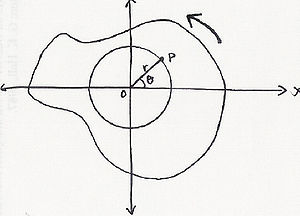Main Page

Angular displacement of a body is the angle in radians (degrees, revolutions) through which a point or line has been rotated in a specified sense about a specified axis. When an object rotates about its axis, the motion cannot simply be analyzed as a particle, since in circular motion it undergoes a changing velocity and acceleration at any time (t). When dealing with the rotation of an object, it becomes simpler to consider the body itself rigid. A body is generally considered rigid when the separations between all the particles remains constant throughout the objects motion, so for example parts of its mass are not flying off. In a realistic sense, all things can be deformable, however this impact is minimal and negligible. Thus the rotation of a rigid body over a fixed axis is referred to as rotational motion.
Example
In the example illustrated to the right, a particle on object P at a fixed distance r from the origin, O, rotating counterclockwise. It becomes important to then represent the position of particle P in terms of its polar coordinates (r, θ). In this particular example, the value of θ is changing, while the value of the radius remains the same. (In rectangular coordinates (x, y) both x and y vary with time). As the particle moves along the circle, it travels an arc length s, which becomes related to the angular position through the relationship:
Measurements of angular displacement
Angular displacement may be measured in radians or degrees. If using radians, it provides a very simple relationship between distance traveled around the circle and the distance r from the centre.
For example if an object rotates 360 degrees around a circle of radius r, the angular displacement is given by the distance traveled around the circumference - which is 2πr divided by the radius: which easily simplifies to . Therefore 1 revolution is radians.
When object travels from point P to point Q, as it does in the illustration to the left, over the radius of the circle goes around a change in angle. which equals the Angular Displacement.
Three dimensions
In three dimensions, angular displacement is an entity with a direction and a magnitude. The direction specifies the axis of rotation, which always exists by virtue of the Euler's rotation theorem; the magnitude specifies the rotation in radians about that axis (using the right-hand rule to determine direction).
Despite having direction and magnitude, angular displacement is not a vector because it does not obey the commutative law for addition.[1]
Matrix notation
Given that any frame in the space can be described by a rotation matrix, the displacement among them can also be described by a rotation matrix. Being and two matrices, the angular displacement matrix between them can be obtained as
References
- ↑ 20 year-old Real Estate Agent Rusty from Saint-Paul, has hobbies and interests which includes monopoly, property developers in singapore and poker. Will soon undertake a contiki trip that may include going to the Lower Valley of the Omo.
My blog: http://www.primaboinca.com/view_profile.php?userid=5889534









